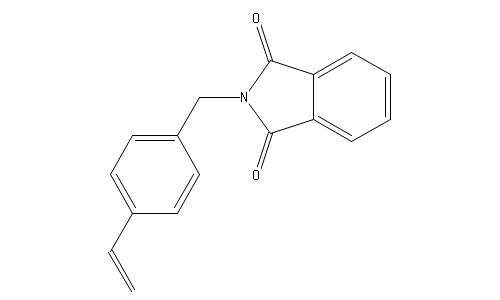Advancements in Flame Retardant N-(4-Vinylbenzyl)Phthalimide (CAS No. 63413-74-1)
N-(4-Vinylbenzyl)Phthalimide (N-VBP), identified by CAS No. 63413-74-1, is a pivotal product offered by UniVOOK Chemical. It serves a dual role: as a flame retardant in electronic materials, crucial for enhancing safety by mitigating fire risks, and as an intermediate in organic synthesis, facilitating the production of diverse organic compounds. Flame retardants like N-VBP play a critical role in electronic materials, ensuring the safety and reliability of electronic devices by preventing fire incidents. UniVOOK Chemical caters to specific industrial needs through customizable manufacturing, meeting varied requirements effectively.

Chemical Structure and Properties
Molecular Structure of N-VBP
N-(4-Vinylbenzyl)Phthalimide (N-VBP) features a distinctive molecular structure comprising a phthalimide group attached to a vinylbenzyl moiety. This configuration is pivotal for its dual functionality as both a flame retardant and an intermediate in organic synthesis. The vinyl group facilitates polymerization processes, enabling its effective integration into diverse materials and chemical reactions.
Physical and Chemical Properties
Physically, N-VBP is typically solid at room temperature, with a melting point conducive to industrial processing. Chemically, it exhibits reactivity, particularly under conditions conducive to the opening of its imide ring—a critical attribute in its role as a chemical intermediate.
Stability and Compatibility with Electronic Materials
N-VBP demonstrates robust thermal stability, crucial for withstanding the high temperatures encountered in electronic manufacturing. This stability prevents decomposition and ensures longevity in electronic applications. Furthermore, its chemical structure ensures compatibility with a broad spectrum of electronic components, enhancing fire resistance and safety in electronic devices.
Applications in Flame Retardancy
Mechanism of Action as a Flame Retardant
N-VBP functions primarily by releasing inert gases upon exposure to heat, which dilute the surrounding oxygen and slow the combustion process. Additionally, it forms a protective char layer on material surfaces, effectively inhibiting the spread of flames and enhancing fire safety.
Effectiveness in Reducing Flammability of Electronic Materials
Extensive testing has demonstrated N-VBP’s efficacy in significantly delaying ignition and reducing burn rates in electronic materials. This characteristic is critical in manufacturing safer electronic devices, where minimizing fire risk is paramount to protecting both property and lives.
Comparison with Other Flame Retardants in Terms of Performance
Compared to traditional halogenated flame retardants, N-VBP offers distinct advantages such as lower toxicity and minimal impact on the physical properties of base materials. Its inert nature ensures environmental friendliness and safety, making it a preferred choice in modern flame retardant applications.
Applications as an Intermediate in Organic Synthesis
Synthesis Routes and Methods to Produce N-VBP
The synthesis of N-VBP involves the reaction of 4-vinylbenzyl chloride with phthalimide, typically catalyzed by a base like sodium hydride. This method ensures controlled production, yielding high purity essential for industrial applications.
Importance in Organic Synthesis Processes
In organic synthesis, N-VBP’s versatility as both a nucleophile and an electrophile enables its participation in diverse chemical reactions. This characteristic facilitates the synthesis of various organic compounds, enhancing its utility across multiple industries.
Examples of Organic Compounds Synthesized Using N-VBP as an Intermediate
N-VBP serves as a crucial building block in the synthesis of polymers, pharmaceuticals, and agrochemicals. For instance, its incorporation into polymer structures enhances flame retardancy, while in pharmaceutical applications, it contributes to the synthesis of bioactive compounds with potential therapeutic benefits. This versatility underscores N-VBP’s significance in advancing chemical innovation and industrial applications.

Advantages and Benefits
Environmental and Safety Advantages Over Traditional Flame Retardants
N-(4-Vinylbenzyl)Phthalimide (N-VBP) provides substantial environmental and safety benefits compared to conventional flame retardants. Unlike halogenated alternatives, N-VBP does not release harmful byproducts into the environment, making it a safer choice for human health and the ecosystem. Its effective flame-retardant properties enhance fire safety in applications, mitigating risks associated with electronic material fires and contributing to sustainable manufacturing practices.
Versatility in Organic Synthesis Applications
N-VBP exhibits remarkable versatility in organic synthesis, serving as a crucial intermediate for synthesizing a diverse array of organic compounds. Its dual role as both a nucleophile and an electrophile enables it to participate in various chemical reactions, making it indispensable for producing complex molecules like pharmaceuticals and polymers. This versatility supports innovation in materials science and pharmaceutical development, expanding its utility across multiple industries.
Economic Benefits in Manufacturing Electronic Materials
Integrating N-VBP into electronic materials manufacturing offers substantial economic advantages by reducing costs associated with fire damage and enhancing product durability. As an effective flame retardant, N-VBP enables manufacturers to achieve stringent safety standards with less material, thereby optimizing production efficiency and lowering overall operational expenses. Its inherent stability contributes to the longevity of electronic components, further enhancing cost-effectiveness and sustainability in manufacturing processes.
Challenges and Considerations
Potential Limitations in Certain Electronic Applications
Despite its effectiveness, N-VBP may face limitations in high-performance electronic applications where specific material properties are critical. Factors such as thermal stability and compatibility with advanced electronic components need careful consideration to ensure optimal performance and reliability in specialized applications.
Safety Considerations During Handling and Processing
Safe handling and processing of N-VBP require adherence to rigorous safety protocols to mitigate potential health risks. Proper personal protective equipment (PPE) for workers and adequate ventilation systems in manufacturing facilities are essential to minimize exposure to any airborne particles or fumes generated during processing operations.
Future Outlook
Emerging Trends in Flame Retardant Technology
Future advancements in flame retardant technology are poised to prioritize sustainability and reduced environmental impact, aligning with global demands for safer and eco-friendly materials. Innovations may focus on developing new compounds with enhanced efficacy while maintaining or improving upon the environmental benefits offered by N-VBP, driving progress in fire safety solutions across industries.
Research and Development Opportunities for N-VBP
Ongoing research and development initiatives are crucial for expanding the application potential of N-VBP and enhancing its performance and safety characteristics. Opportunities exist to optimize synthesis processes, reduce manufacturing costs, and explore novel applications in emerging fields of organic chemistry and materials science. These efforts aim to unlock new capabilities and broaden market opportunities for N-VBP globally.
Potential Applications in Other Industries Beyond Electronics
The versatile properties of N-VBP suggest promising applications beyond electronics, extending into sectors such as automotive, aerospace, and construction materials. Its effective flame retardancy and versatility as a chemical intermediate position it for diverse uses in manufacturing safer and more durable materials across various industrial applications. Exploring new applications underscores N-VBP’s role as a versatile solution for enhancing safety and performance in evolving market landscapes.
In Closing
N-(4-Vinylbenzyl)Phthalimide (N-VBP) is recognized for its versatility and environmental friendliness, finding extensive use in flame retardancy and organic synthesis. Its distinct chemical structure offers superior safety advantages over traditional flame retardants and supports diverse synthesis reactions for creating complex organic compounds. While facing challenges in high-performance applications, ongoing research and stringent adherence to safety and regulatory standards are facilitating its broader acceptance across multiple industries. Emerging trends in flame retardant technology underscore N-VBP’s potential beyond electronics, contributing to advancements in material science and fostering safer, more sustainable industrial practices. With its dual functionality enhancing both safety and efficiency, N-VBP meets the growing global demand for eco-friendly and high-performance materials.
Access Our Product Catalog and More to Discover High-Performance Chemicals Tailored to Your Business Needs





